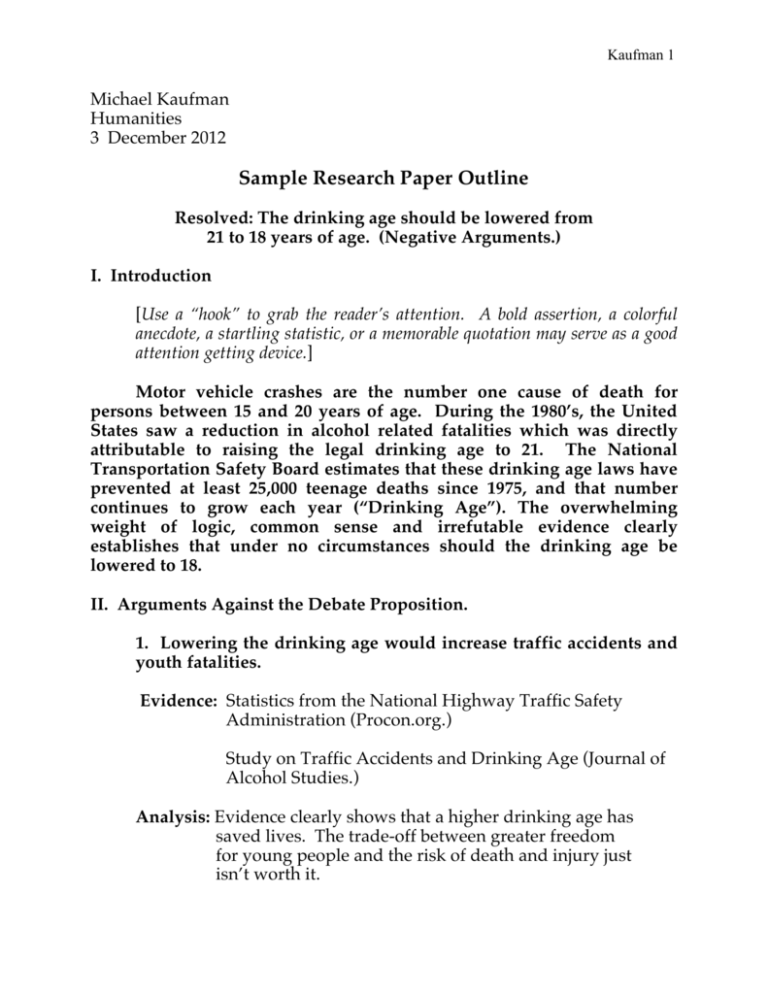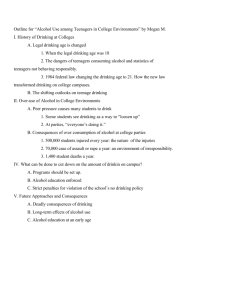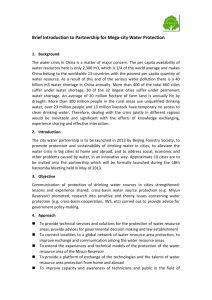Sample Detailed Outline
advertisement

Kaufman 1 Michael Kaufman Humanities 3 December 2012 Sample Research Paper Outline Resolved: The drinking age should be lowered from 21 to 18 years of age. (Negative Arguments.) I. Introduction [Use a “hook” to grab the reader’s attention. A bold assertion, a colorful anecdote, a startling statistic, or a memorable quotation may serve as a good attention getting device.] Motor vehicle crashes are the number one cause of death for persons between 15 and 20 years of age. During the 1980’s, the United States saw a reduction in alcohol related fatalities which was directly attributable to raising the legal drinking age to 21. The National Transportation Safety Board estimates that these drinking age laws have prevented at least 25,000 teenage deaths since 1975, and that number continues to grow each year (“Drinking Age”). The overwhelming weight of logic, common sense and irrefutable evidence clearly establishes that under no circumstances should the drinking age be lowered to 18. II. Arguments Against the Debate Proposition. 1. Lowering the drinking age would increase traffic accidents and youth fatalities. Evidence: Statistics from the National Highway Traffic Safety Administration (Procon.org.) Study on Traffic Accidents and Drinking Age (Journal of Alcohol Studies.) Analysis: Evidence clearly shows that a higher drinking age has saved lives. The trade-off between greater freedom for young people and the risk of death and injury just isn’t worth it. Kaufman 2 2. Lowering the drinking age to 18 interferes with healthy brain development and poses severe mental health risks. Evidence: Medical science shows that brain development isn’t complete until mid-20’s. Alcohol consumption harms this development and also leads to unsafe/risky behaviors, depression, violence, alcoholism and suicide. (U.S. Department of Public Health Study; American Academy Pediatrics Study – from Procon.org.) Analysis: Young adulthood is already a challenging time for many psychologically. Potential health risks for young people, particularly the severe mental health risks, support maintaining the 21 year drinking age. 3. Lowering the drinking age will give high school and even middle school students greater access to alcohol. Evidence: “Trickle-down” effect of alcohol purchases is only logical. Surveys show that most common source for alcohol among 18-20 year olds is their 21-24 year old peers. (“Youth Access to Alcohol”.) Analysis: Lowering the drinking age will not only harm older teens, but even younger adolescents who lack the maturity to handle these dangerous substances. Alcoholism is likely to rise. 4. Many adult rights in the U.S. begin at 21 or older; the dangers posed by alcohol justify a higher legal age than 18. Evidence: Analysis: III. Opponents’ Likely Counterarguments and Responses. Supporters of the debate proposition are likely to argue as follows: Kaufman 3 1. Eighteen is the age of adulthood in the U.S. and adults should have the right to make their own decisions about alcohol consumption. Counterargument: While 18 year olds have the right to vote, in many other respects they have not reached adulthood. Biologically, their brains are still developing, few support themselves economically, and most importantly many lack the emotional maturity and judgment to use alcohol safely. 2. Lowering the drinking age will allow 18 to 20 year olds to drink alcohol safely in regulated environments and thus learn responsible drinking habits. Counterargument: This assertion relies on the naïve and false assumption that young drinkers will limit alcohol consumption to bars, restaurants and other supervised locations. Nothing could be further from the truth. Alcohol is already a fixture of the high school social scene and will become even more so (and even extend downward to middle school students) if the drinking age is lowered. 3. European and Latin American societies enforce a lower drinking age without any of the horrible consequences described by the negative side in this debate. Counterargument: Those societies differ in many important cultural and economic respects from the U.S. Public transportation is more widely available there. Their practices cannot be simply transferred to the U.S. without many negative consequences. IV. Conclusion [Conclude your essay with a powerful appeal to logic, shared values, or emotion, demonstrating that your position is unquestionably the most reasonable one in this debate.]






